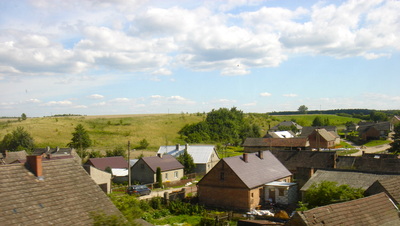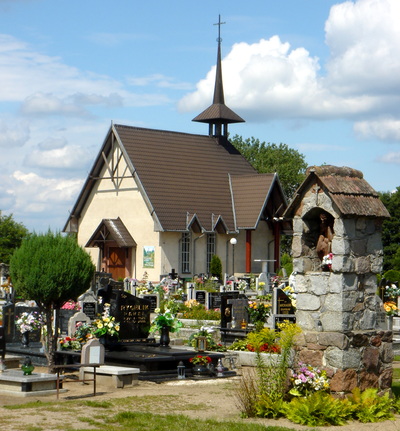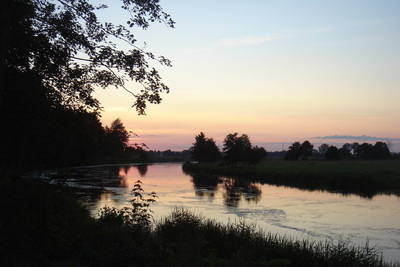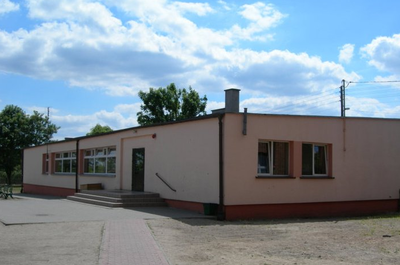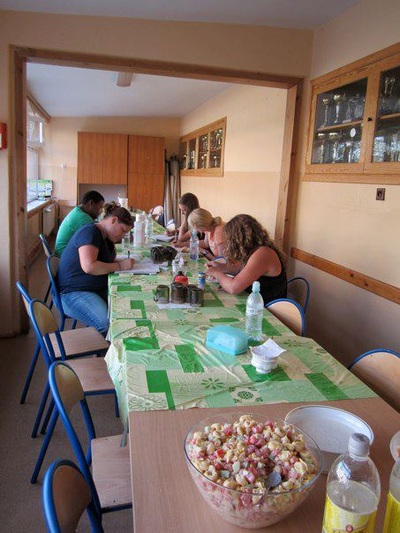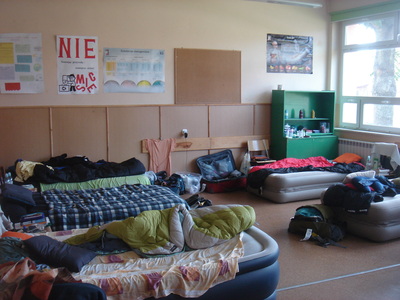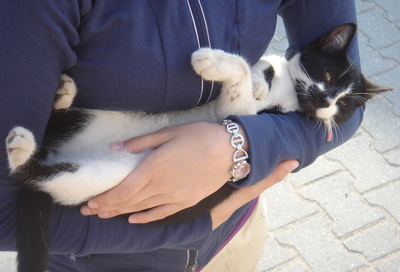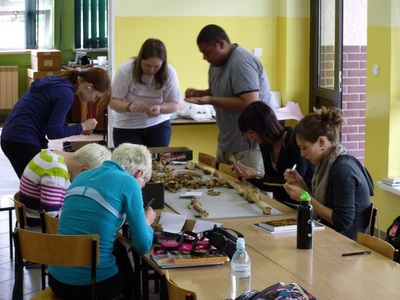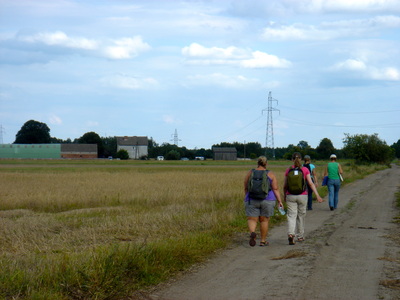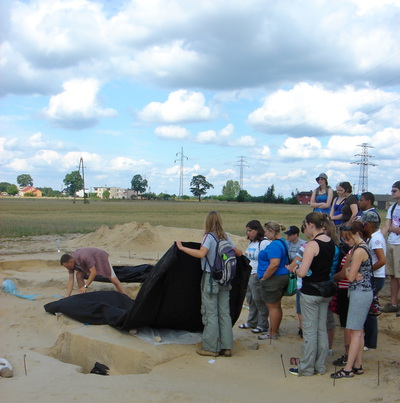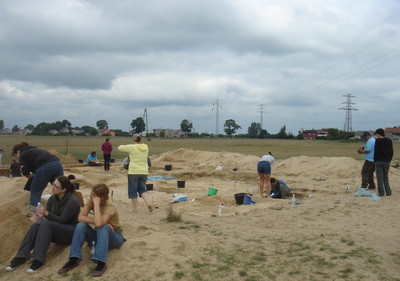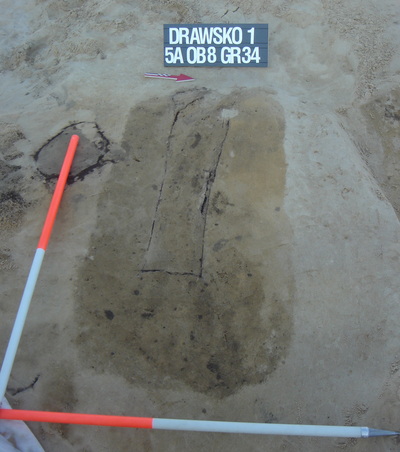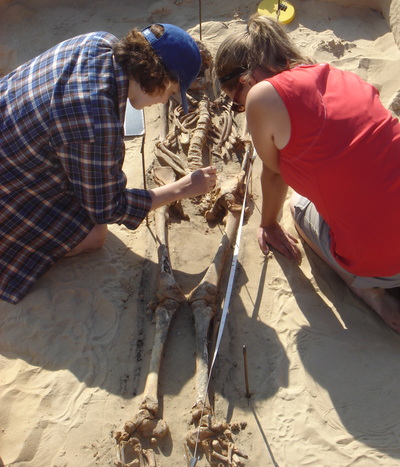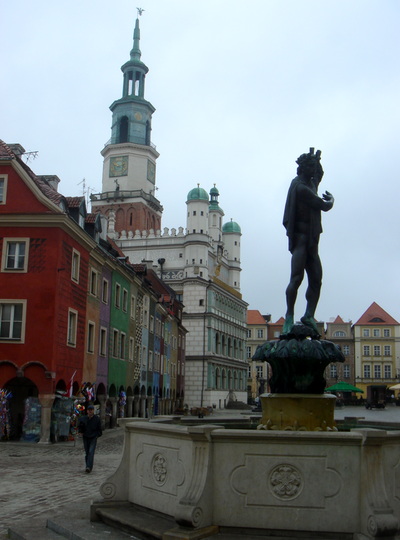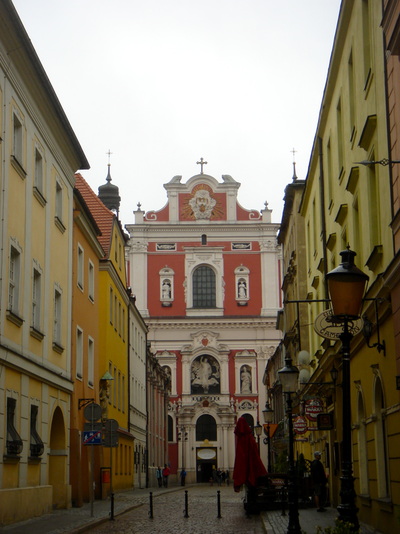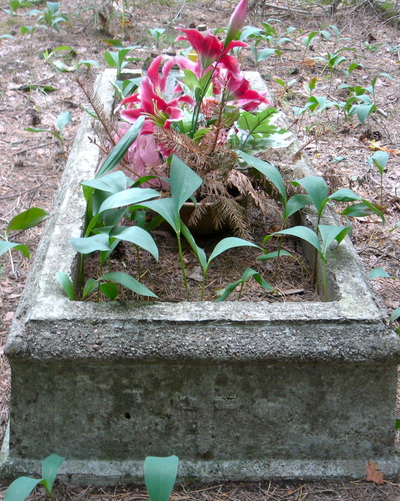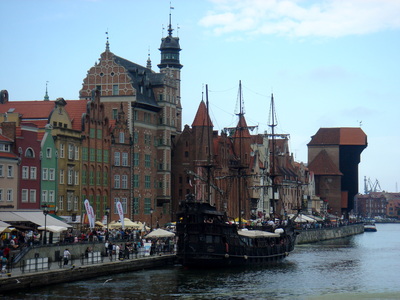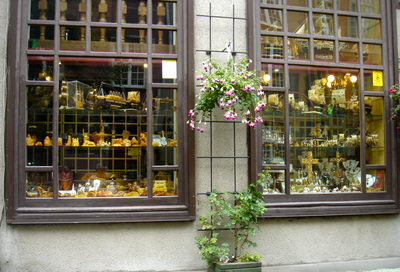*This review was written by me, the author of ArchaeoDirt. I attended the Slavia Field School in 2011. This review may be a little outdated, but I hope it will serve as a model for future reviews.
FIELD SCHOOL & WEBSITE: Slavia Field School in Mortuary Archaeology
LOCATION: Drawsko, Poland
AFFILIATIONS: Foundation for Polish History & Culture, Museum of Czarnków Soil, Slavia Foundation,
Adam Mickiewicz University, State University of New York at Oneonta, SOCRATES European
Education Exchange Program
HISTORY: The Slavia Summer Field School in Archaeology was established in 1998. In 2008, excavations
began in Drawsko, where they continue today.
CURRENT PROJECT: Drawsko is a multiperiod burial site with an extensive cemetery dating to the 17th
century. Students participate in excavation of burials and cremations as well as laboratory work and
osteological analyses.
STAFF: Current staff include both Polish archaeologists as well as professors from SUNY Oneonta,
the University of Newfoundland, and the University of Nevada, Reno.
LENGTH & DATES: Two sessions are offered each summer. This summer (2015), Session 1 runs June
29 - July 22, and Session 2 runs July 23 - August 15.
STUDENTS PER SESSION: ~20
COST PER SESSION: $2,990. Cost includes full room and board, food, transportation to and from the
site, tuition, and equipment. Students are responsible for air fare to and from Poland as well as
personal spending money.
CREDIT AVAILABLE: 6 credits are offered through Adam Mickiewicz University.
APPLICATION PROCESS: Fill out the application form and submit it with a letter of intent. Upon
acceptance, a $500 deposit must be submitted.
DEADLINES: Applications are accepted on a rolling basis until all spaces are filled.
Tell us about your field school experience.
All in all, it was a great experience. Right off the bat they were very organized. Students were directed to a Facebook group where we could meet our fellow field students and coordinate travel to Poland. Our group rendezvoused in Poznan, the nearest major city to Drawsko. It was an easy trip via Frankfurt, and I had no problems connecting with the organizers at a designated hotel. Once the group was together, we took a bus to Drawsko. As a junior in college at the time, this was one of my first times traveling internationally, but everything went off without a hitch. They provided us with good instructions, which helped with the nerves of travel.
Each day, the students were split into a field group and a lab group. They took care to make sure that we each got lots of experience in both area, but they also gave us time to see through each disinterment we worked on from start to finish. Staff were always available for help and I never felt any lack of guidance. They also took the handling of human remains very seriously and made it clear that they expected us to be respectful, which I appreciated.
During the weekends, we had the opportunity to travel and arrange our own excursions. These trips were not an official part of the field school, but the staff was always happy to help with recommendations and logistics. Some students planned trips into Germany, or to major sites around Poland. I went on one trip into Poznan and, on the weekend that happened to coincide with my birthday, we went to Gdansk, a city on the Baltic Sea. The language barrier never posed any major problems, and overall I found Poland easy to navigate.
What skills did you learn?
The focus of the field school was two fold, and included both field and laboratory work. In the field, we learned about grave and burial excavation and documentation, feature recognition, mapping, data collection, topographic survey, artifact recovery, and the disinterment of skeletal materials.
In the lab, we learned about the analysis and curation of skeletal materials. Students were involved in cleaning and inventorying the remains. We also gained experience in creating biological profiles, assessing pathological and traumatic features, and constructing basic demographic information for the population.
I found the field school to be a great opportunity to brush up on my osteology skills. They advertise the program as being geared toward people with no osteology background, but I felt like it was a little more advanced than that. For those of us with prior knowledge, it was a great opportunity to review bones, their features, and how to side them. For those with no knowledge, learning all of that within 4 weeks was tough, but still doable. Regular lab quizzes kept us accountable, but the staff made sure the classes and quizzes were fun rather than just "work." I walked away significantly more confident in my skeletal knowledge.
How were accommodations?
The field school was located in the local school which was, of course, empty over the summer. The school complex included classrooms, a kitchen, a dining and social area, bathrooms, and a gym. Some of the classrooms functioned as dorms, while others were used for our laboratory time and lectures. We slept 6-7 people per room and were provided with air mattresses. All in all, the accommodations were pretty comfortable. The showers often ran out of hot water and 4 weeks on an air mattress gets old, but I was happy to have showers and an air mattress.
What are the pros and cons of this field school? Would you recommend it?
Overall, I would definitely recommend this field school for anyone with an interest in osteology and mortuary archaeology.
First, here are a few of the pros. The archaeology is great. The cemetery we were excavating had no shortage of graves, and they were all fascinating. There were lots of grave goods, and many individuals were buried in strange positions. The staff was also wonderful. The American and Canadian graduate students leading the group were kind and helpful. The Polish archaeologists working on the project were also fantastic. Some spoke more English than others, but all of them were eager to make sure we enjoyed our time in their country. I also really, really appreciated how well organized the field school was. Our schedule was always clear, and there was never any confusion about who was doing what, when.
And now, some of the cons. I wish we had learned a bit more about Polish history and culture. Despite spending 4 weeks there, I left feeling as if I wasn't much better acquainted with Poland than I had been when I arrived. I also didn't feel as integrated into the local community as I would have liked. We rarely interacted with locals who weren't in some way associated with the program, and it felt like there was a bit of a divide between the field school and the village of Drawsko. However, my perception may have been affected by my other experiences- just a few weeks before I went to Poland I had been working on a project in Peru where we felt very connected with the community.
Anything else you think readers should know about this field school?
A local catering service brought all our meals, and primarily served traditional Polish food. As a vegetarian, I was excited that they were willing to accommodate vegetarians- but, to any fellow veggies out there, be aware that you will be eating a LOT of fried cheese, potatoes, and bread. Some of the students bought additional snacks at the small shops in Drawsko, but I found the food they provided to be more than enough.
Keep in mind that Drawsko is very, very small and rural. It's beautiful and incredibly quaint, but if you are hoping for constant excitement and things to do you may be disappointed. However, the town does have a small local bar, a few shops and restaurants, and a post office. There is also a marina on the river, and lots of nice places to walk.
Also think about what skills you are hoping to walk away with. This field school is great for brushing up on your osteology skills and learning about the excavation of human remains. However, since the work you are doing is so specific, you may find that you are skipping some of the basic skills you'll need as an archaeologist. In the years since I attended this field school, I have had to back pedal a bit to learn some of the archaeological basics. After Drawsko, I could excavate a grave no problem. However, had I been asked to excavate a basic unit around a thermal feature I would have had some trouble. If you want to dedicate your career to human skeletal remains, then this might not bother you, but keep in mind that developing a broad, well-rounded skill set will help you enormously throughout your career.
FIELD SCHOOL & WEBSITE: Slavia Field School in Mortuary Archaeology
LOCATION: Drawsko, Poland
AFFILIATIONS: Foundation for Polish History & Culture, Museum of Czarnków Soil, Slavia Foundation,
Adam Mickiewicz University, State University of New York at Oneonta, SOCRATES European
Education Exchange Program
HISTORY: The Slavia Summer Field School in Archaeology was established in 1998. In 2008, excavations
began in Drawsko, where they continue today.
CURRENT PROJECT: Drawsko is a multiperiod burial site with an extensive cemetery dating to the 17th
century. Students participate in excavation of burials and cremations as well as laboratory work and
osteological analyses.
STAFF: Current staff include both Polish archaeologists as well as professors from SUNY Oneonta,
the University of Newfoundland, and the University of Nevada, Reno.
LENGTH & DATES: Two sessions are offered each summer. This summer (2015), Session 1 runs June
29 - July 22, and Session 2 runs July 23 - August 15.
STUDENTS PER SESSION: ~20
COST PER SESSION: $2,990. Cost includes full room and board, food, transportation to and from the
site, tuition, and equipment. Students are responsible for air fare to and from Poland as well as
personal spending money.
CREDIT AVAILABLE: 6 credits are offered through Adam Mickiewicz University.
APPLICATION PROCESS: Fill out the application form and submit it with a letter of intent. Upon
acceptance, a $500 deposit must be submitted.
DEADLINES: Applications are accepted on a rolling basis until all spaces are filled.
Tell us about your field school experience.
All in all, it was a great experience. Right off the bat they were very organized. Students were directed to a Facebook group where we could meet our fellow field students and coordinate travel to Poland. Our group rendezvoused in Poznan, the nearest major city to Drawsko. It was an easy trip via Frankfurt, and I had no problems connecting with the organizers at a designated hotel. Once the group was together, we took a bus to Drawsko. As a junior in college at the time, this was one of my first times traveling internationally, but everything went off without a hitch. They provided us with good instructions, which helped with the nerves of travel.
Each day, the students were split into a field group and a lab group. They took care to make sure that we each got lots of experience in both area, but they also gave us time to see through each disinterment we worked on from start to finish. Staff were always available for help and I never felt any lack of guidance. They also took the handling of human remains very seriously and made it clear that they expected us to be respectful, which I appreciated.
During the weekends, we had the opportunity to travel and arrange our own excursions. These trips were not an official part of the field school, but the staff was always happy to help with recommendations and logistics. Some students planned trips into Germany, or to major sites around Poland. I went on one trip into Poznan and, on the weekend that happened to coincide with my birthday, we went to Gdansk, a city on the Baltic Sea. The language barrier never posed any major problems, and overall I found Poland easy to navigate.
What skills did you learn?
The focus of the field school was two fold, and included both field and laboratory work. In the field, we learned about grave and burial excavation and documentation, feature recognition, mapping, data collection, topographic survey, artifact recovery, and the disinterment of skeletal materials.
In the lab, we learned about the analysis and curation of skeletal materials. Students were involved in cleaning and inventorying the remains. We also gained experience in creating biological profiles, assessing pathological and traumatic features, and constructing basic demographic information for the population.
I found the field school to be a great opportunity to brush up on my osteology skills. They advertise the program as being geared toward people with no osteology background, but I felt like it was a little more advanced than that. For those of us with prior knowledge, it was a great opportunity to review bones, their features, and how to side them. For those with no knowledge, learning all of that within 4 weeks was tough, but still doable. Regular lab quizzes kept us accountable, but the staff made sure the classes and quizzes were fun rather than just "work." I walked away significantly more confident in my skeletal knowledge.
How were accommodations?
The field school was located in the local school which was, of course, empty over the summer. The school complex included classrooms, a kitchen, a dining and social area, bathrooms, and a gym. Some of the classrooms functioned as dorms, while others were used for our laboratory time and lectures. We slept 6-7 people per room and were provided with air mattresses. All in all, the accommodations were pretty comfortable. The showers often ran out of hot water and 4 weeks on an air mattress gets old, but I was happy to have showers and an air mattress.
What are the pros and cons of this field school? Would you recommend it?
Overall, I would definitely recommend this field school for anyone with an interest in osteology and mortuary archaeology.
First, here are a few of the pros. The archaeology is great. The cemetery we were excavating had no shortage of graves, and they were all fascinating. There were lots of grave goods, and many individuals were buried in strange positions. The staff was also wonderful. The American and Canadian graduate students leading the group were kind and helpful. The Polish archaeologists working on the project were also fantastic. Some spoke more English than others, but all of them were eager to make sure we enjoyed our time in their country. I also really, really appreciated how well organized the field school was. Our schedule was always clear, and there was never any confusion about who was doing what, when.
And now, some of the cons. I wish we had learned a bit more about Polish history and culture. Despite spending 4 weeks there, I left feeling as if I wasn't much better acquainted with Poland than I had been when I arrived. I also didn't feel as integrated into the local community as I would have liked. We rarely interacted with locals who weren't in some way associated with the program, and it felt like there was a bit of a divide between the field school and the village of Drawsko. However, my perception may have been affected by my other experiences- just a few weeks before I went to Poland I had been working on a project in Peru where we felt very connected with the community.
Anything else you think readers should know about this field school?
A local catering service brought all our meals, and primarily served traditional Polish food. As a vegetarian, I was excited that they were willing to accommodate vegetarians- but, to any fellow veggies out there, be aware that you will be eating a LOT of fried cheese, potatoes, and bread. Some of the students bought additional snacks at the small shops in Drawsko, but I found the food they provided to be more than enough.
Keep in mind that Drawsko is very, very small and rural. It's beautiful and incredibly quaint, but if you are hoping for constant excitement and things to do you may be disappointed. However, the town does have a small local bar, a few shops and restaurants, and a post office. There is also a marina on the river, and lots of nice places to walk.
Also think about what skills you are hoping to walk away with. This field school is great for brushing up on your osteology skills and learning about the excavation of human remains. However, since the work you are doing is so specific, you may find that you are skipping some of the basic skills you'll need as an archaeologist. In the years since I attended this field school, I have had to back pedal a bit to learn some of the archaeological basics. After Drawsko, I could excavate a grave no problem. However, had I been asked to excavate a basic unit around a thermal feature I would have had some trouble. If you want to dedicate your career to human skeletal remains, then this might not bother you, but keep in mind that developing a broad, well-rounded skill set will help you enormously throughout your career.
